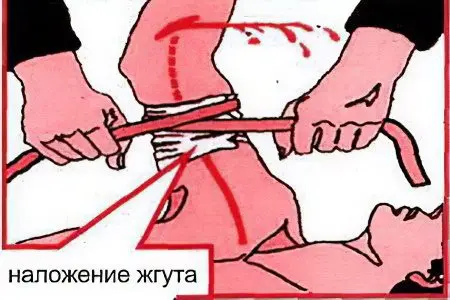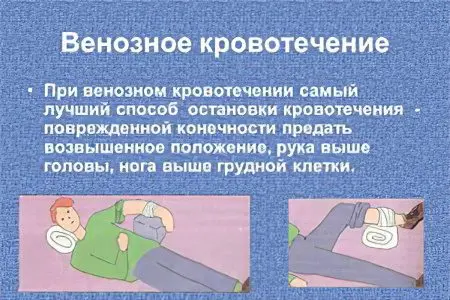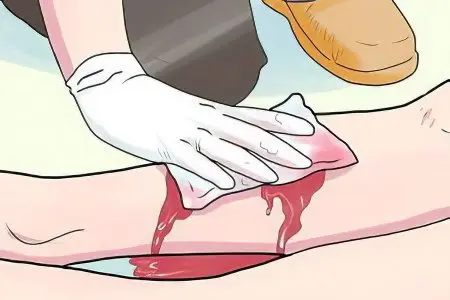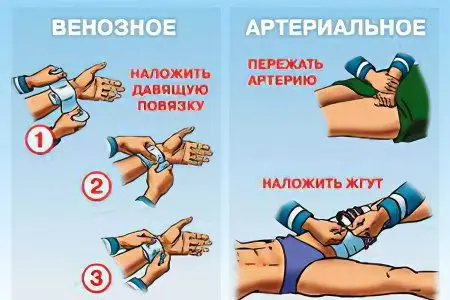Contents
What is bleeding?
Bleeding is the loss of blood that occurs due to damage to blood vessels. The integrity of the vessels can be broken by trauma, purulent fusion, increased blood pressure, and the action of toxins. Changes in blood chemistry can also cause bleeding. It provokes a wide range of diseases: sepsis, scarlet fever, hemophilia, jaundice, scurvy, and so on.
When bleeding occurs in the body cavity (abdominal, pleural), it is called internal. Bleeding into the tissue is called a hematoma. If any tissue is diffusely saturated with blood, they speak of a hemorrhage (into the subcutaneous tissue, brain tissue, etc.)
There are several general classifications of bleeding.
According to the time of bleeding can be:

primary (occur immediately after injury or tissue damage);
early secondary (occur after a few hours or after injury, before infection enters the wound);
late secondary (begin after the development of infection in the wound).
Depending on the severity and loss of blood, bleeding can be:
first degree (loss of circulating blood no more than 5%);
second degree (loss of circulating blood about 15%);
third degree (loss of circulating blood about 30%);
the fourth degree (loss of circulating blood more than 30%).
Symptoms of bleeding
Symptoms of bleeding depend on its type and the type of damaged vessels.
Arterial bleeding occurs when the arteries (carotid, femoral, axillary, etc.) are damaged. It is the most dangerous, since blood is ejected very quickly, in a pulsating stream. Rapidly comes acute anemia; the color of blood is bright scarlet. The victim becomes pale, his pulse is quickened, blood pressure drops rapidly, dizziness, nausea and vomiting, and fainting appear. Death can occur due to oxygen starvation or cardiac arrest.
Venous bleeding occurs when the integrity of the veins is violated. The blood flows in an even continuous stream and has a dark cherry color. If the intravenous pressure is not too high, the blood may spontaneously stop: a fixed clot forms. But bleeding leads to the occurrence of shock phenomena in the body, which often leads to death.
Capillary bleeding is the least dangerous and stops on its own. Blood oozes from the wound, damaged vessels are not visible. The danger of capillary bleeding is only in diseases that affect blood clotting (hemophilia, sepsis, hepatitis).
Parenchymal bleeding occurs when all the blood vessels in the area of injury are damaged. It is dangerous, usually very strong and prolonged.
Also, bleeding symptoms may depend on the location of the injury. If bleeding occurs inside the skull, the brain is compressed, a pressing sensation appears in the head, especially in the temporal part. Pleural bleeding (hemothorax) leads to compression of the lung, the appearance of shortness of breath. Ruptures in the abdominal cavity cause an accumulation of blood in it (hemoperitoneum): a person has abdominal pain, nausea and vomiting. Bleeding into the cavity of the cardiac membrane causes a decrease in the activity of the heart, cyanosis; venous pressure is increased.
When bleeding occurs within a joint, its volume increases. When palpation of the joint or movements, the person feels severe pain. Interstitial hematoma is characterized by swelling, pain on palpation, and a sharp pallor of the skin. If timely treatment is not carried out, the hematoma will squeeze the veins, which can lead to the development of gangrene of the limb.
Arterial bleeding and first aid

Arterial bleeding is one of the most dangerous bleeding that poses a direct threat to human life. This is primarily due to the fact that blood loss is high and intense. Therefore, it is important to know its main signs and first aid rules.
Arteries are blood vessels, blood circulates through them and is delivered to all vital organs. If the artery is damaged as a result of any traumatic factor, then the blood from it begins to flow outward. It is not difficult to understand that arterial bleeding is not difficult, it is characterized by such signs as: bright scarlet color of blood, it is liquid in consistency, does not flow out of the wound, but beats with a powerful stream, similar to a jet in a fountain. There is always a pulsation that occurs in time with the contraction of the heart muscle. Since the blood is expelled very quickly, the person may experience vasospasm and loss of consciousness.
First aid algorithm for arterial bleeding
The rules for first aid will vary, depending on where the injury is located and which artery has been damaged:
First of all, it is necessary to apply a tourniquet, which will prevent blood loss. Before fixing it, it is important to press the injured artery against the bone, above the place where the blood flows from. If the shoulder is wounded, the fist is inserted into the armpit, and the arm is pressed against the body; if the forearm is wounded, place any suitable object in the elbow bend and bend the arm as much as possible in this joint. If the thigh is wounded, the artery is clamped with a fist in the inguinal region, if the shin is wounded, the corresponding object is placed in the popliteal zone and the leg is bent at the joint.
The limb should be raised, a tissue should be placed under the tourniquet. When there is no rubber band at hand, it can be replaced with an ordinary bandage or a strip of cloth. For a tighter fixation, you can use a regular stick.
It is important not to overexpose the tourniquet on the limb, it must be removed after 1 – 1,5 hours, depending on the time of year. It is best to record the time of its application on paper and put it under the bandage. This must be done so that tissue death does not occur, and amputation of the limb is not required.
When the time for wearing the tourniquet has expired, and the victim is not hospitalized, it is necessary to loosen it for a few minutes. In this case, the wound should be clamped with hands, using a clean cloth.
As soon as possible, deliver the victim to a medical facility where he will be provided with qualified assistance.
The rules for helping with the occurrence of arterial bleeding from the feet, as well as the hands, differ. In this case, there is no need to apply a tourniquet. It is enough to bandage the injured place and lift it higher.
When such arteries as the subclavian, iliac, carotid or temporal are injured, the blood is stopped with the help of a tight tamponade of the wound. To do this, either sterile cotton wool or sterile wipes are put into the damaged area, then a layer of bandage is applied on top and wrapped tightly.
Venous bleeding and first aid

Venous bleeding is characterized by the outpouring of blood from the veins, as a result of their damage. Through the veins, blood enters the heart from the capillaries that lower the organs and tissues.
To understand that a person has venous bleeding, it is necessary to focus on the following signs: the blood is colored dark red or cherry. It does not pour out in a fountain, but flows out of the wound slowly and fairly evenly. Even if large veins were injured and the bleeding is profuse, there is still no pulsation. If it does, it will be slightly perceptible, which is explained by the irradiation of impulses from a nearby artery.
Venous bleeding is no less dangerous than arterial bleeding. In this case, a person can die not only because of the profuse loss of blood, but also because of the absorption of air through the veins and its delivery to the heart muscle. Air trapping occurs when inhaling during an injury to a large vein, especially in the neck, and is called an air embolism.
First aid algorithm for venous bleeding
In this case, there is no need to apply a tourniquet and the first aid rules are as follows:
If the vein of the limb is injured, then it must be raised up. This is done in order to reduce the flow of blood to the damaged area.
Then you should start applying a pressure bandage. For this purpose, there is an individual dressing package. If this is not at hand, then a clean napkin or cloth folded several times is applied to the wound, after which it is wrapped with a bandage on top. Put a handkerchief over the bandage.
The place of application of such a bandage is below the injury site. It is important to apply a bandage tightly and in a circle, otherwise it will only provoke an increase in blood output.
The criterion for assessing the correctness of the actions performed is the absence of bleeding and the presence of pulsation below the injury site.
When there is no clean tissue at hand, you should clamp the damaged limb in the joint as hard as possible, or squeeze the place just below the blood outlet with your fingers.
In any case, the victim should be hospitalized.
Sometimes, with heavy bleeding, it is not possible to stop it with the help of a bandage alone. In this case, it is advisable to use a tourniquet. It is applied below the wound, which is due to the way blood is delivered to the heart muscle through the veins.
Capillary bleeding and first aid
Capillary bleeding is the most common bleeding. It does not pose a threat to human life, since capillaries are the smallest vessels that penetrate all tissues and organs. It has its own distinctive features. The blood flowing from the capillaries has a bright scarlet color, the discharge is not intense, since the pressure in this case will be minimal, the pulsation is completely absent.
First aid algorithm for capillary bleeding
The rule of first aid for capillary bleeding is simple.
In this case, the application of a tourniquet is not required, it is enough to confine ourselves to the following actions:
Wash and disinfect the wound.
The injured place should be pulled tightly, but in such a way as not to disturb the flow of arterial and venous blood, that is, not too much.
Apply cold to the wound site, which will constrict the blood vessels.
If a person has a superficial wound and no other injuries, then hospitalization is not required.
Parenchymal bleeding and first aid

Parenchymal bleeding is bleeding that occurs in the internal organs, which is characterized by profuse blood loss. The only way to stop it is through surgery. The parenchyma organs include the lungs, liver, kidneys, and spleen. Since their tissue is extremely delicate, even a slight injury to it leads to profuse bleeding.
To determine parenchymal bleeding, you need to focus on the following signs: general weakness, dizziness, fainting, blanching of the skin, low pulsation with a rapid heartbeat, a drop in blood pressure. Depending on which organ was injured or sick, it will be possible to suspect parenchymal bleeding of the lungs, liver, kidneys, etc.
First aid algorithm for parenchymal bleeding
Since this type of blood loss is dangerous to human life, it is necessary to act quickly:
The victim should be sent to a medical facility as soon as possible. If it is not possible to call an ambulance, then you need to go on your own.
Neither pressure bandages nor the application of tourniquets in this case will affect the amount of blood lost.
Before the arrival of the medical team, a person needs rest. To do this, lay it in a horizontal position, and slightly raise your legs.
Ice should be applied to the area where bleeding is suspected. If the transportation of the patient to the medical facility is delayed, then you can use such means as: Vikasol, Etamzilat, Aminocaproic acid.
Only a surgeon is able to stop parenchymal bleeding. Depending on the nature of the damage, complex sutures will be applied, vessels will be emobilized and electrocoagulated, the omentum will be sutured, and other surgical methods will be applied. In some cases, it requires parallel blood transfusion and the use of saline solutions.
Gastrointestinal bleeding and first aid
Gastrointestinal bleeding deserves special attention, as they are life-threatening conditions. It is important not to miss the first signs of such blood loss and seek help from a specialist in time. Among them, the following can be distinguished: hematemesis with brown impurities, the presence of liquid bloody stools, pallor of the skin, increased heart rate with reduced blood pressure, general weakness accompanied by dizziness, and sometimes loss of consciousness.
First aid algorithm for gastrointestinal bleeding
In order to stop gastrointestinal bleeding, a person must be taken to a hospital.
However, first aid will be as follows:
A person needs complete rest. For this, it is best to put him to bed.
A cold heating pad or ice pack should be placed on the abdomen.
You can prick some ice and give it to the person in small portions so that he swallows it.
Take the victim to the hospital.
First aid for bleeding

The provision of first aid for any type of bleeding is either a complete stop or a slowdown in blood loss until the victim is in the hands of a specialist. It is important to be able to distinguish between types of bleeding and be able to properly use improvised means to stop them. Although it is better to always have bandages, cotton wool, a tourniquet, an individual dressing bag and disinfectants in the first-aid kit and in personal vehicles. Two important rules for providing first aid are not to harm a person and act quickly, because in some cases every minute is important.
In order to properly provide first aid for bleeding, you need:
Apply a tourniquet above the wound if the bleeding is arterial.
Apply tampons and dressings below the wound if bleeding is venous.
Disinfect and bandage the wound if the bleeding is capillary.
Lay the person in a horizontal position, apply cold to the injured area and take him to the hospital as soon as possible if the bleeding is parenchymal or gastrointestinal.
It is important to properly clamp a vein or vessel in order to gain time and have time to deliver a person to a hospital, or transfer it to an ambulance team. The doctors who came to the call, if everything is done correctly, will not bandage the tourniquet or bandage. They can give a person an intravenous injection of solutions of Vikasol, or Calcium Chloride, or another hemostatic agent, measure blood pressure, and, if necessary, administer drugs to normalize cardiac activity. Then the person will be handed over to the surgeon.
Knowing the basic rules, you can one day save the life of not only another person, but also yourself.









